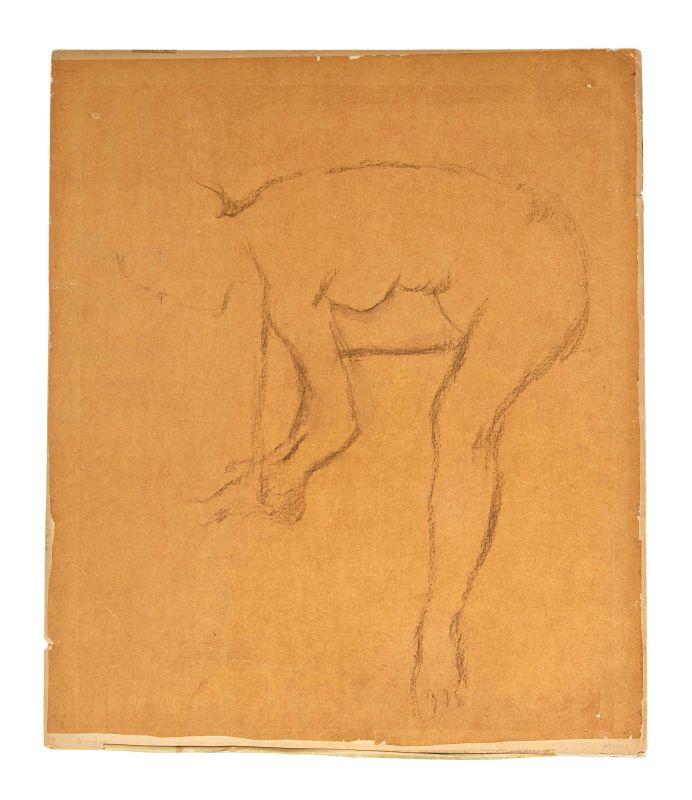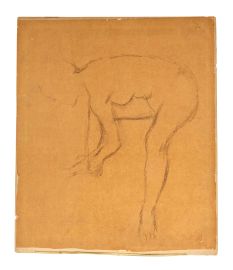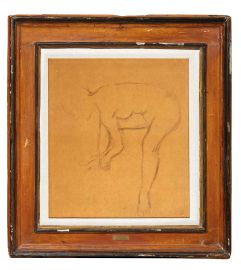Edgar Degas
(Paris 1834 - 1917)
FEMME S’ESSUYANT LE PIED
1880 circa
pastello nero su carta applicata su cartone
mm 624x535
FEMME S’ESSUYANT LE PIED
circa 1880
black crayon on paper laid down on cardboard
24 5/8 by 21 in
L’opera è accompagnata da certificato di autenticità rilasciato da Brame & Lorenceau il 6 giugno 2019.
This work is accompanied by a certificate of authenticity issued by Brame & Lorenceau on 6th June 2019.
L’opera è corredata di attestato di libera circolazione.
An export license is available for this lot.
Provenienza
Fevre
Hotel Drouot, Paris, 14 giugno 1985, n. 3
New York, William Doyle Galleries, fine anni ‘80
La figura femminile senza dubbio è oggi uno dei soggetti più noti della produzione di Edgar Degas dagli anni Settanta dell’Ottocento in avanti. Di spiccato risultato naturalistico, dovuto specialmente alla straordinaria precisione e solidità del tratto grafico, il soggetto, stando agli archivi della galleria parigina Brame & Lorenceau, corrisponde a uno studio di donna intenta ad asciugarsi un piede. Considerate tuttavia le chiare e manifeste assonanze tra le opere, pare evidente che il bozzetto sia stato riutilizzato da Degas come studio preparatorio per un’altra composizione, Ballerina che si allaccia la scarpetta destra (New York, collezione privata, cfr. L’opera completa di Degas, a cura di F. Minervino, Milano 1970, p. 121, n. 747), pastello su carta del 1880, anno a cui si può pertanto far risalire il nostro disegno. Il corpo della modella si presenta qui nudo, indagato in assenza di qualsiasi vestiario, come appare dal dettaglio dei piedi. Questo particolare è testimone del metodo di lavoro degasiano, che prima di tutto prendeva il via da uno studio attento e pedissequo dell’anatomia umana, per poi concentrarsi, in maniera ossessiva, sui movimenti e sulle numerose posizioni del corpo femminile, mediante un’analisi approfondita della sua struttura meccanica e motoria e delle sue complesse gestualità. In qualche modo, il lavoro rituale delle ballerine sembra esprimere in sé un equivalente dei procedimenti dello stesso Degas. Il disegno divenne per lui, in età matura, lo strumento prediletto per esprimere la vitalità del proprio incontro con la danzatrice, in una perfetta mediazione tra l’istantaneità del momento e il lavoro d’atelier. Il risultato di questa indagine sul corpo della donna, evidente nel nostro disegno, è una composizione di grande libertà espressiva, ma profondamente legata al vero, scevra da ogni tipo di idealizzazione. Le dimensioni sembrano inquadrare l’opera nelle famose serie di studi laboriosamente concepiti da Degas come un ampio repertorio di pose femminili da cui poter attingere secondo le esigenze del momento.
Today, the female figure is one of the best-known subjects of Edgar Degas’ production from the 1870s onward. His results are conspicuously naturalistic, thanks in large part to the extraordinary precision and solidity of his graphic sign. The subject, we learn from the archives of the Brame & Lorenceau gallery of Paris, is a woman drying her foot; considering the clear and manifest assonances between the works, it appears evident that Degas repurposed the sketch as a preparatory study for a different composition altogether, Dancer Tying Her Right Shoe (New York, private collection. Cf. F. Minervino (ed.), L’opera completa di Degas, Milano 1970, p. 121, no. 747), a pastel on paper from 1880, the year to which our sketch may therefore be dated. In our sketch, the model’s body is nude, studied unencumbered by any article of clothing, as is evident in the detail of the feet. This is indicative of Degas’ working method: before all else, he based his representations on detailed, meticulous study of human anatomy to later concentrate – obsessively – on the movements of the female body and the many positions it can assume, through in-depth analysis of its mechanical structure and motor capabilities and its complex gestural expressiveness. In a sense, the rituals of the work of the dancers could be seen as equivalents of Degas’ own working processes. Drawing was the mature Degas’ preferred way for expressing the vitality of his meeting with the dancer, as it struck a perfect balance between the instantaneousness of the moment and the repetitive work of the atelier. The result of his investigation of the woman’s body in our drawing is a composition marked by great expressive freedom yet closely linked to life and devoid of any type of idealisation. The dimensions seem to place the work in the famous series of studies conceived and laboriously assembled by Degas as an ample repertory of female poses on which to draw to satisfy his figurative needs as the moment demanded.








